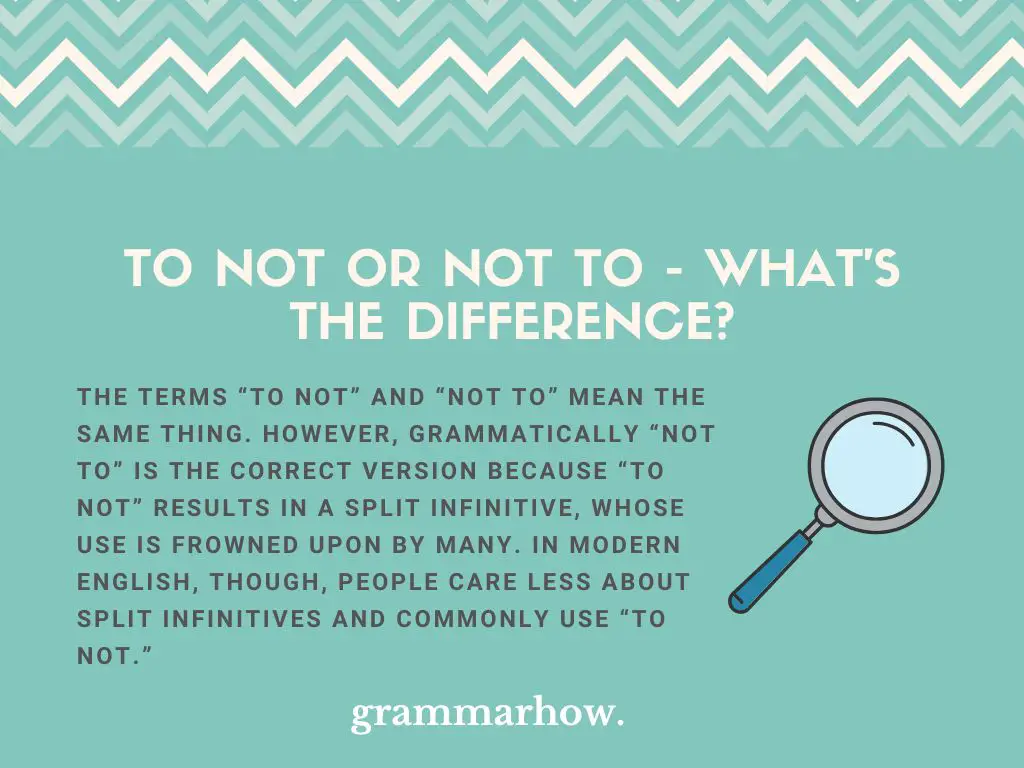The phrases “to not” and “not to” appear commonly in English, and knowing which one to use is slightly tricky. This page examines and explains both phrases and shows how they are used in sentences.
To Not or Not To – What’s the Difference?
The terms “to not” and “not to” mean the same thing. However, grammatically “not to” is the correct version because “to not” results in a split infinitive, whose use is frowned upon by many. In modern English, though, people care less about split infinitives and commonly use “to not.”

An infinitive verb in English is the base form of the verb, i.e. “to go”, to eat”, “to sleep”, etc.
In decades past, it was viewed as extremely “incorrect” to place anything between these two words because you are “splitting the infinitive.” However, in modern English, which is less formal than it once was, splitting infinitives is not something that generates as much controversy as it once did.
Therefore, both versions are used and acceptable. However, to avoid splitting the infinitive, it is safer to use “not to”, especially in any formal writing.
Here are some examples with the terms in context:
- His essay was an example of how not to write an essay.
- His essay was an example of how to not write an essay. – Split infinitive
- He is trying not to drink too much anymore.
- He is trying to not drink much anymore. – Split infinitive
To Not
The term “to not” is seen and heard quite frequently. However, using it with a verb results in a “split infinitive”, which some grammar purists frown upon.
Modern English is not slightly more informal than it once was, and rules such as the “split infinitive” are not as controversial as they once were.
Having said that, if you are writing an essay or formal writing, it is advisable to invert the term so it becomes “not to”, which avoids “split infinitives.”
Here are some examples of “to not” in a sentence: Please note that “some” people would class these sentences as “incorrect” because of the “split infinitive.”
- She has been trying to not eat sugar.
- It’s okay to not know what you want to do when you are older.
- I am sorry to not know your name.
- He said to not only read the book but also to understand it.
Not To
The term “not to” is the more correct version of the terms “not to” and “to not” because it avoids creating a “split infinitive” in the sentence.
“Split infinitives” are not viewed negatively as they once were. However, on most occasions, especially in formal writing, “not to” is considered the correct version of negation.
Here are some examples of “not to” in a sentence:
- He has been trying not to go out so much because he is saving.
- You were not to know that we started early because you weren’t here yesterday.
- I am sorry not to have been more helpful.
- He said not only to read the book but also to understand it.
Conclusion
Of the terms “not to” and “to not”, the preferred option is “not to” because it avoids the split infinitive that “to not” creates. Split infinitives are not viewed as negatively as they once were, but you should try to avoid them, especially in formal or academic English.

Martin holds a Master’s degree in Finance and International Business. He has six years of experience in professional communication with clients, executives, and colleagues. Furthermore, he has teaching experience from Aarhus University. Martin has been featured as an expert in communication and teaching on Forbes and Shopify. Read more about Martin here.
